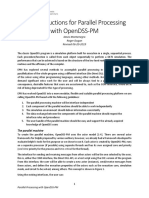PostgreSQL Internals and Performance Optimization
Uploaded by
FrancesHsiehPostgreSQL Internals and Performance Optimization
Uploaded by
FrancesHsiehPostgreSQL Internals
and
Performance Optimization
MinervaDB Inc., 340 S LEMON AVE #9718 WALNUT 91789 CA, US
Speaker Bio
• Name: Shiv Iyer
• Occupation: Founder and Principal of MinervaDB
• Technology focus:
• Open Source Database Systems
• Transaction processing systems
• Database Systems optimizers and internals
• Performance optimization and tuning
• Capacity Planning and Sizing
• MySQL – InnoDB and RocksDB (MyRocks)
• MariaDB
• PostgreSQL
MinervaDB Inc., 340 S LEMON AVE #9718 WALNUT 91789 CA, US
The scope of the talk
• PostgreSQL Architecture and Internals
• PostgreSQL Query Performance Troubleshooting
• Optimal Indexing
• Missing Indexes
• Unused Indexes
• Configuring PostgreSQL for Performance
• PostgreSQL Partitioning
MinervaDB Inc., 340 S LEMON AVE #9718 WALNUT 91789 CA, US
Safe Harbor Statement
The following is intended to outline our general direction in PostgreSQL
infrastructure operations. It is intended for information purposes only,
and may not be incorporated into any contract. It is not a commitment
to deliver any material, code, or functionality, and should not be relied
upon in making purchasing decisions. The development, release, and
timing of any features or functionality described for MinervaDB’s
products, consulting, support and remote DBA services remains at the
sole discretion of MinervaDB Inc.
MinervaDB Inc., 340 S LEMON AVE #9718 WALNUT 91789 CA, US
PostgreSQL Architecture components
PostgreSQL is a multi-process Relational Database Management System:
• Server processes
• Archiver
• Statistics collector
• WAL writer
• Background writer
• Autovacuum launcher
• Checkpointer
• Logging collector
• Client processes
• Postgres backend processes
• Memory structure
• Shared memory area
• Local memory area
• Database Cluster
MinervaDB Inc., 340 S LEMON AVE #9718 WALNUT 91789 CA, US
PostgreSQL Architecture Explained
MinervaDB Inc., 340 S LEMON AVE #9718 WALNUT 91789 CA, US
PostgreSQL Architecture and Internals
Postmaster PostgreSQL Server Processes
§ Archiver
§ Statistics collector
§ WAL writer
§ Background writer
Backend Process § Autovacuum launcher
§ Checkpointer
§ Logging collector
Handles
incoming Backend Process
connections
Backend Process
PostgreSQL Memory Structure
• Shared memory area
• Local memory area Database Cluster
MinervaDB Inc., 340 S LEMON AVE #9718 WALNUT 91789 CA, US
PostgreSQL Processes
Background process Description
Archiver Process accountable for archive logging
Statistics collector Statistics data (pg_stat_activity, pg_stat_user_indexes etc.) required for troubleshooting PostgreSQL more
intuitively is collected by the process Statistics Collector
WAL writer Process to flush WAL data from WAL buffer to a persistent storage / disk
Background writer Process to flush dirty pages in shared buffer pool to a persistent storage / disk ( In PostgreSQL 9.1 or earlier,
Background writer was also accountable for checkpoint process )
Autovacuum launcher Process involved in periodical auto vacuum activity
Checkpointer Checkpoint process ( included from PostgreSQL 9.2)
Logging collector Process to record error incidents to log files
MinervaDB Inc., 340 S LEMON AVE #9718 WALNUT 91789 CA, US
PostgreSQL Memory Structure explained
Postmaster
PostgreSQL Server Processes
Backend Process
Handles
incoming Backend Process
connections
Database Cluster
Backend Process
PostgreSQL Memory Structure
• Shared memory area – Consumed by all process of PostgreSQL
• Local memory area – Allotted to each individual PostgreSQL process
MinervaDB Inc., 340 S LEMON AVE #9718 WALNUT 91789 CA, US
Shared Memory Area
Shared Memory Area Description
Shared buffer pool PostgreSQL caches pages from tables and indexes to shared buffer pool from
persistent storage / disk for optimal performance.
WAL buffer To ensure zero data loss, PostgreSQL retains transaction logs in WAL file. The WAL
data is stored in WAL buffer before writing to a persistent storage.
Commit log To ensure data concurrency and reliability, the commit log maintains states of entire
transactions – in-progress, committed and aborted.
MinervaDB Inc., 340 S LEMON AVE #9718 WALNUT 91789 CA, US
Local Memory Area
Local Memory Area Description
Temporary buffer The local buffer area used to access temporary table data.
Work_mem The local buffer area used by sort memory operations and hash tables
before using temporary data files.
Maintenance_work_mem The local buffer area used for maintenance operations like adding
foreign keys to existing tables, creating indexes, vacuum etc.
MinervaDB Inc., 340 S LEMON AVE #9718 WALNUT 91789 CA, US
Building PostgreSQL Infrastructure Operations
for Performance
MinervaDB Inc., 340 S LEMON AVE #9718 WALNUT 91789 CA, US
Why performance tuning is a journey ?
• Measure PostgreSQL query performance to understand Data Access Path:
• Data logic changes with new business rules, This internally sometimes conflicts with PostgreSQL statistics and
execution plans.
• PostgreSQL tools used to troubleshoot performance
• Indexes causes pain with the data volume growth, We may have to create or remove indexes on a
regular interval for retaining an optimal PostgreSQL performance.
• PostgreSQL infrastructure footprint (database volume and transactions) grows continuously with
your business velocity and acceleration, So every fast growing company should plan building
database infrastructure capacity for the future to avoid unpleasant performance bottlenecks at a
scale.
• Larger tables are operationally expensive and exhaustive, Table partitioning efficiently
compartmentalize data across multiple partitions to distribute I/O and also address database
archiving.
MinervaDB Inc., 340 S LEMON AVE #9718 WALNUT 91789 CA, US
Troubleshooting PostgreSQL query performance
using pg_stat_statements
MinervaDB Inc., 340 S LEMON AVE #9718 WALNUT 91789 CA, US
pg_stat_statements
• Officially bundled with PostgreSQL for troubleshooting the
performance.
• pg_stat_statements is also known as PostgreSQL contrib extension,
Which can found in contrib directory of PostgreSQL distribution.
• pg_stat_statements does not record individual queries, It
parameterizes them and save as aggregated reports.
• By using pg_stat_statements, You can measure PostgreSQL
performance by “Response Time”.
• We strongly recommend you to increase OS shared memory limits
while using pg_stat_statements for optimal performance.
MinervaDB Inc., 340 S LEMON AVE #9718 WALNUT 91789 CA, US
How to us pg_stat_statements?
MinervaDB Inc., 340 S LEMON AVE #9718 WALNUT 91789 CA, US
Install and configure pg_stat_statements
On Debian / Ubuntu:
# Replace 9.X with your installed Postgres version:
sudo apt-get install postgresql-contrib-9.X
On CentOS / RedHat:
sudo yum install postgresql-contrib
Configure PostgreSQL adding following entries to postgres.conf:
shared_preload_libraries = 'pg_stat_statements’
# You can increase the max size of the query strings Postgres records if you have large complicated queries executed in PostgreSQL infra.
track_activity_query_size = 2048
# Record queries generated by stored procedures also
pg_stat_statements.track = all
MinervaDB Inc., 340 S LEMON AVE #9718 WALNUT 91789 CA, US
Example
SELECT campaign_master.campaign_category,
campaign_master.campaign_id,
campaign_master.publisher_id
FROM campaign_master,
publisher_master
WHERE campaign_master.publisher_id =publisher_master.publisher_id
AND
publisher_master.publisher_category = ‘Social Gaming’;
MinervaDB Inc., 340 S LEMON AVE #9718 WALNUT 91789 CA, US
pg_stat_statements parameterize the queries
SELECT campaign_master.campaign_category,
campaign_master.campaign_id,
campaign_master.publisher_id
FROM campaign_master,
publisher_master
WHERE campaign_master.publisher_id =publisher_master.publisher_id
AND
publisher_master.publisher_category = ‘?’;
MinervaDB Inc., 340 S LEMON AVE #9718 WALNUT 91789 CA, US
Monitoring PostgreSQL query performance
with pg_stat_statements
SELECT
(total_time / 100 / 60) as Total,
(total_time/calls) as Avg,
query
FROM pg_stat_statements
ORDER BY 1
DESC LIMIT 100;
# In the SQL above we have captured queries on “Response Time” , The total latency of individual
queries is reported in minutes and average latency on milliseconds.
MinervaDB Inc., 340 S LEMON AVE #9718 WALNUT 91789 CA, US
Output from pg_stat_statements
Total | Avg | query
----------+--------+---------
936.72 | 91.86 | SELECT campaign_category FROM campaign_master...
513.18 | 16.38 | SELECT campaign_id FROM campaign_master...
(2 rows)
MinervaDB Inc., 340 S LEMON AVE #9718 WALNUT 91789 CA, US
PostgreSQL Auto Explain
• Automatically logs the execution plans of slow queries in PostgreSQL
without you manually running EXPLAIN.
• A module in the contrib package.
• Can be enabled in postgresql.conf by setting parameter
auto_explain.log_min_duration and the library for all sessions by
setting shared_preload_libraries = auto_explain
• We strongly recommend you not to enable auto_explain.log_analyze
in production unless you are really confident about handling extra
performance bottleneck due to this setting.
MinervaDB Inc., 340 S LEMON AVE #9718 WALNUT 91789 CA, US
2020-07-09 17:26:54.645 IST [15129] postgres@postgres LOG: duration: 0.292 ms plan:
SELECT campaign_master.campaign_category,
campaign_master.campaign_id,
campaign_master.publisher_id
FROM campaign_master,
publisher_master
WHERE campaign_master.publisher_id =publisher_master.publisher_id
AND
publisher_master.publisher_category = ‘Social Gaming’;
Aggregate (cost=26.34..26.35 rows=168 width=8) (actual time=4.278..0.278 rows=1 loops=1)
-> Hash Join (cost=19.70..25.93 rows=11364 width=0) (actual time=5.215..0.267 rows=128 loops=1)
Hash Cond: (publisher_master.publisher_id = campaign_master.publisher_id )
-> Seq Scan on pg_index (cost=0.00..5.80 rows=3164 width=4) (actual time=0.014..0.042 rows=1128 loops=1)
Filter: indisunique
Rows Removed by Filter: 18
-> Hash (cost=15.42..15.42 rows=342 width=4) (actual time=6.166..0.166 rows=4367 loops=1)
Buckets: 1024 Batches: 1 Memory Usage: 7MB
-> Seq Scan on pg_class (cost=0.00..15.42 rows=3142 width=4) (actual time=3.007..0.106 rows=4367 loops=1)
MinervaDB Inc., 340 S LEMON AVE #9718 WALNUT 91789 CA, US
Monitoring index usage
• Optimal indexing is very important for PostgreSQL performance
• You can efficiently troubleshoot PostgreSQL performance with
following data:
• Missing indexes
• Unused indexes
• Enable PostgreSQL statistics collector to monitor missing and unused
indexes by setting following parameters:
• track_activities
• track_counts
• track_functions
• track_io_timing
MinervaDB Inc., 340 S LEMON AVE #9718 WALNUT 91789 CA, US
Missing indexes
SELECT
relname,
seq_scan - idx_scan AS too_much_seq,
CASE
WHEN
seq_scan - coalesce(idx_scan, 0) > 0
THEN
'Missing Index?’
ELSE
'OK’
END,
pg_relation_size(relname::regclass) AS rel_size, seq_scan, idx_scan
FROM
pg_stat_all_tables
WHERE schemaname = 'public’
AND pg_relation_size(relname::regclass) > 80000
ORDER BY
too_much_seq DESC;
MinervaDB Inc., 340 S LEMON AVE #9718 WALNUT 91789 CA, US
Unused indexes
SELECT
indexrelid::regclass as index,
relid::regclass as table,
'DROP INDEX ' || indexrelid::regclass || ';' as drop_statement
FROM pg_stat_user_indexes
JOIN pg_index USING (indexrelid)
WHERE idx_scan = 0
AND
indisunique is false;
MinervaDB Inc., 340 S LEMON AVE #9718 WALNUT 91789 CA, US
PostgreSQL partitioning
• Efficient distribution of data and transaction I/O.
• Most often / frequently accessed data and indexes can be partitioned
for performance by efficiently fitting in the memory.
• Partitioning enables high performance sequential scan of records in
the table compared to using an index and random access reads
scattered across the whole table.
• PostgreSQL partition types:
• RANGE: Data in Tables partitioned over a range of values.
• HASH: Tables Partitioned by specifying a modulus and a remainder for each partition.
• LIST: Tables partitioned by explicitly listing which key values appear in each partition.
MinervaDB Inc., 340 S LEMON AVE #9718 WALNUT 91789 CA, US
Configuring PostgreSQL for Performance
• shared_buffers
• PostgreSQL support double buffering, i.e. PostgreSQL uses its native internal buffer and kernel buffered
IO. Increasing shared_buffers in a READ intensive infrastructure will benefit in performance, fitting
entire database in RAM is good.
• wal_buffers
• PostgreSQL writes WAL records to wal_buffers. You can set higher values for wal_buffers if expected
more concurrent session with heavy WRITEs / UPDATEs.
• effective_cache_size
• The effective_cache_size is how much memory is available for disk caching by the operating system and
within the database itself , This parameter is used by PostgreSQL optimizer / query planner to decide
whether the execution plans can fit in the memory, We strongly recommend to set this value up to 80%
of the RAM and setting this value too low may influence query planner not to use few indexes at all
causing serious performance bottleneck.
MinervaDB Inc., 340 S LEMON AVE #9718 WALNUT 91789 CA, US
Configuring PostgreSQL for Performance
• work_mem
• work_mem configuration parameter makes complex PostgreSQL SORT / SEARCH operations optimal.
But, This is a “per session” (allocated exclusively for each concurrent SORT operations ) configuration
parameter and so we strongly recommend to keep this value low to avoid excessive swapping and out-
of-memory errors. The default value is 4MB.
• maintenance_work_mem
• maintenance_Work_mem defines how much memory is allocated for routine Database
Infrastructure Operations maintenance activities like adding foreign keys to existing tables,
index operations (CREATE / ALTER / DROP) and VACUUM. Since PostgreSQL maintenance
operations do not run concurrently you can set this value definitely higher than work_mem.
The default value is 64MB
MinervaDB Inc., 340 S LEMON AVE #9718 WALNUT 91789 CA, US
Contacts
• Email: shiv@minervadb.com
• Twitter: https://twitter.com/thewebscaledba
• Facebook page: https://www.facebook.com/DataOpsGeek/
• GitHub: https://github.com/shiviyer
• Contact MinervaDB: contact@minervadb.com
• Contact MinervaDB Support: support@minervadb.com
MinervaDB Inc., 340 S LEMON AVE #9718 WALNUT 91789 CA, US
You might also like
- Apache Cassandra Administrator Associate - Exam Practice TestsFrom EverandApache Cassandra Administrator Associate - Exam Practice TestsNo ratings yet
- MySQL Performance Tuning - MySQL 8 Query Performance Tuning - A Systematic Method For Improving Execution SpeedsNo ratings yetMySQL Performance Tuning - MySQL 8 Query Performance Tuning - A Systematic Method For Improving Execution Speeds3 pages
- Migrate From Oracle To Postgresql With Azure: Webinar SeriesNo ratings yetMigrate From Oracle To Postgresql With Azure: Webinar Series21 pages
- Netezza Oracle Configuration in DatastageNo ratings yetNetezza Oracle Configuration in Datastage8 pages
- Unit 1 Maintenance Management and Terotechnology: An OverviewNo ratings yetUnit 1 Maintenance Management and Terotechnology: An Overview9 pages
- Postgresql Tuning Guide: Postgresql Architecture: Key TakeawaysNo ratings yetPostgresql Tuning Guide: Postgresql Architecture: Key Takeaways8 pages
- [Ebooks PDF] download PostgreSQL High Availability Cookbook Master over 100 recipes to design and implement a highly available server with the advanced features of PostgreSQL 2nd Edition Shaun M. Thomas full chapters100% (3)[Ebooks PDF] download PostgreSQL High Availability Cookbook Master over 100 recipes to design and implement a highly available server with the advanced features of PostgreSQL 2nd Edition Shaun M. Thomas full chapters53 pages
- Optimizing MySQL Server Settings CodingpediaNo ratings yetOptimizing MySQL Server Settings Codingpedia6 pages
- Postgresql Triggers (Tae 2) : Subject: Dbms Guided By: Prof. Neha Purohit - Submitted By: Varun Dalal (Cse - 4-C-25)No ratings yetPostgresql Triggers (Tae 2) : Subject: Dbms Guided By: Prof. Neha Purohit - Submitted By: Varun Dalal (Cse - 4-C-25)21 pages
- Knowledge Transfer Data Redaction On EnterpriseDBNo ratings yetKnowledge Transfer Data Redaction On EnterpriseDB19 pages
- How To Set Up PostgreSQL For High Availability and Replication With Hot StandbyNo ratings yetHow To Set Up PostgreSQL For High Availability and Replication With Hot Standby11 pages
- CS8492 /database Management Systems 2017 RegulationsNo ratings yetCS8492 /database Management Systems 2017 Regulations20 pages
- Mongodb Vs Couchbase Architecture WP PDFNo ratings yetMongodb Vs Couchbase Architecture WP PDF45 pages
- Postgresql Cluster Kurulumu (Repmgr + Haproxy) by Alparslan Ozturk MediumNo ratings yetPostgresql Cluster Kurulumu (Repmgr + Haproxy) by Alparslan Ozturk Medium6 pages
- WEBINAR2012 03 Optimizing MySQL ConfigurationNo ratings yetWEBINAR2012 03 Optimizing MySQL Configuration43 pages
- Security Best Practices For Postgresql: WhitepaperNo ratings yetSecurity Best Practices For Postgresql: Whitepaper14 pages
- Mongodb Cookbook: Chapter No.1 "Installing and Starting The Mongodb Server"100% (1)Mongodb Cookbook: Chapter No.1 "Installing and Starting The Mongodb Server"40 pages
- Oracle Performance Improvement by Tuning Disk Input OutputNo ratings yetOracle Performance Improvement by Tuning Disk Input Output4 pages
- SQL Server 2008/2012: Database Administrator Class 1No ratings yetSQL Server 2008/2012: Database Administrator Class 169 pages
- Transact-SQL Syntax Conventions (Transact-SQL)No ratings yetTransact-SQL Syntax Conventions (Transact-SQL)2 pages
- SQL Server Query Optimization Techniques PDFNo ratings yetSQL Server Query Optimization Techniques PDF9 pages
- Rolling Upgrade To SQL Server Database MirroringNo ratings yetRolling Upgrade To SQL Server Database Mirroring4 pages
- Rolling Upgrade To SQL Server Database MirroringNo ratings yetRolling Upgrade To SQL Server Database Mirroring4 pages
- Oracle Metadata: Data Dictionary vs. Dynamic Performance ViewsNo ratings yetOracle Metadata: Data Dictionary vs. Dynamic Performance Views1 page
- Oracle SQL Loader - Conventional Path vs. Direct PathNo ratings yetOracle SQL Loader - Conventional Path vs. Direct Path2 pages
- Elementary Data Structures - Stacks, Queues, & Lists, Amortized Analysis TreesNo ratings yetElementary Data Structures - Stacks, Queues, & Lists, Amortized Analysis Trees41 pages
- Automating Oracle Database Startup and Shutdown On Linux SOP100% (1)Automating Oracle Database Startup and Shutdown On Linux SOP3 pages
- Heat-Shrink Terminations (HVT-Z-J/SJ) : For JCN Cables (15 - 35 KV)No ratings yetHeat-Shrink Terminations (HVT-Z-J/SJ) : For JCN Cables (15 - 35 KV)2 pages
- Analysis On Market and Business Strategy of Honda, DHS Motors LimitedNo ratings yetAnalysis On Market and Business Strategy of Honda, DHS Motors Limited30 pages
- A PPG Sensor For Continuous Cuffless Blood Pressure Monitoring With Self-Adaptive Signal ProcessingNo ratings yetA PPG Sensor For Continuous Cuffless Blood Pressure Monitoring With Self-Adaptive Signal Processing4 pages
- Session 5 Validation GAMP and Baseline Guide CompatibilityNo ratings yetSession 5 Validation GAMP and Baseline Guide Compatibility11 pages
- User Instructions For Parallel Processing With Opendss-Pm: Davis Montenegro Roger Dugan Revised 06-20-2019No ratings yetUser Instructions For Parallel Processing With Opendss-Pm: Davis Montenegro Roger Dugan Revised 06-20-20199 pages
- Resilience-In-Transport-And-Logistics-02-20 McKinseyNo ratings yetResilience-In-Transport-And-Logistics-02-20 McKinsey8 pages
- 240V Class: To 175 HP 480V Class: 1 To 1000 HP 600V Class: 2 To 250 HPNo ratings yet240V Class: To 175 HP 480V Class: 1 To 1000 HP 600V Class: 2 To 250 HP52 pages
- Asia Pacific College The School of Management: ITTOOLS: Reflection Paper SGV Cyber Roadshow: Cracking The Code To SuccessNo ratings yetAsia Pacific College The School of Management: ITTOOLS: Reflection Paper SGV Cyber Roadshow: Cracking The Code To Success3 pages
- Fire Voice 25-50 Instrucciones de OperaciónNo ratings yetFire Voice 25-50 Instrucciones de Operación1 page
- Procedure For Design and Development Control-01No ratings yetProcedure For Design and Development Control-0129 pages
- Apache Cassandra Administrator Associate - Exam Practice TestsFrom EverandApache Cassandra Administrator Associate - Exam Practice Tests
- MySQL Performance Tuning - MySQL 8 Query Performance Tuning - A Systematic Method For Improving Execution SpeedsMySQL Performance Tuning - MySQL 8 Query Performance Tuning - A Systematic Method For Improving Execution Speeds
- Migrate From Oracle To Postgresql With Azure: Webinar SeriesMigrate From Oracle To Postgresql With Azure: Webinar Series
- Unit 1 Maintenance Management and Terotechnology: An OverviewUnit 1 Maintenance Management and Terotechnology: An Overview
- Postgresql Tuning Guide: Postgresql Architecture: Key TakeawaysPostgresql Tuning Guide: Postgresql Architecture: Key Takeaways
- [Ebooks PDF] download PostgreSQL High Availability Cookbook Master over 100 recipes to design and implement a highly available server with the advanced features of PostgreSQL 2nd Edition Shaun M. Thomas full chapters[Ebooks PDF] download PostgreSQL High Availability Cookbook Master over 100 recipes to design and implement a highly available server with the advanced features of PostgreSQL 2nd Edition Shaun M. Thomas full chapters
- Postgresql Triggers (Tae 2) : Subject: Dbms Guided By: Prof. Neha Purohit - Submitted By: Varun Dalal (Cse - 4-C-25)Postgresql Triggers (Tae 2) : Subject: Dbms Guided By: Prof. Neha Purohit - Submitted By: Varun Dalal (Cse - 4-C-25)
- How To Set Up PostgreSQL For High Availability and Replication With Hot StandbyHow To Set Up PostgreSQL For High Availability and Replication With Hot Standby
- CS8492 /database Management Systems 2017 RegulationsCS8492 /database Management Systems 2017 Regulations
- Postgresql Cluster Kurulumu (Repmgr + Haproxy) by Alparslan Ozturk MediumPostgresql Cluster Kurulumu (Repmgr + Haproxy) by Alparslan Ozturk Medium
- Security Best Practices For Postgresql: WhitepaperSecurity Best Practices For Postgresql: Whitepaper
- Mongodb Cookbook: Chapter No.1 "Installing and Starting The Mongodb Server"Mongodb Cookbook: Chapter No.1 "Installing and Starting The Mongodb Server"
- Oracle Performance Improvement by Tuning Disk Input OutputOracle Performance Improvement by Tuning Disk Input Output
- SQL Server 2008/2012: Database Administrator Class 1SQL Server 2008/2012: Database Administrator Class 1
- Oracle Metadata: Data Dictionary vs. Dynamic Performance ViewsOracle Metadata: Data Dictionary vs. Dynamic Performance Views
- Oracle SQL Loader - Conventional Path vs. Direct PathOracle SQL Loader - Conventional Path vs. Direct Path
- Elementary Data Structures - Stacks, Queues, & Lists, Amortized Analysis TreesElementary Data Structures - Stacks, Queues, & Lists, Amortized Analysis Trees
- Automating Oracle Database Startup and Shutdown On Linux SOPAutomating Oracle Database Startup and Shutdown On Linux SOP
- Heat-Shrink Terminations (HVT-Z-J/SJ) : For JCN Cables (15 - 35 KV)Heat-Shrink Terminations (HVT-Z-J/SJ) : For JCN Cables (15 - 35 KV)
- Analysis On Market and Business Strategy of Honda, DHS Motors LimitedAnalysis On Market and Business Strategy of Honda, DHS Motors Limited
- A PPG Sensor For Continuous Cuffless Blood Pressure Monitoring With Self-Adaptive Signal ProcessingA PPG Sensor For Continuous Cuffless Blood Pressure Monitoring With Self-Adaptive Signal Processing
- Session 5 Validation GAMP and Baseline Guide CompatibilitySession 5 Validation GAMP and Baseline Guide Compatibility
- User Instructions For Parallel Processing With Opendss-Pm: Davis Montenegro Roger Dugan Revised 06-20-2019User Instructions For Parallel Processing With Opendss-Pm: Davis Montenegro Roger Dugan Revised 06-20-2019
- Resilience-In-Transport-And-Logistics-02-20 McKinseyResilience-In-Transport-And-Logistics-02-20 McKinsey
- 240V Class: To 175 HP 480V Class: 1 To 1000 HP 600V Class: 2 To 250 HP240V Class: To 175 HP 480V Class: 1 To 1000 HP 600V Class: 2 To 250 HP
- Asia Pacific College The School of Management: ITTOOLS: Reflection Paper SGV Cyber Roadshow: Cracking The Code To SuccessAsia Pacific College The School of Management: ITTOOLS: Reflection Paper SGV Cyber Roadshow: Cracking The Code To Success





















































































































